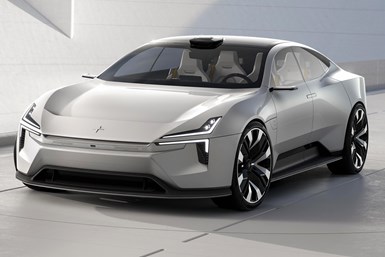Fastback EV Previews Polestar’s Design Direction
Sleek concept distances the fledgling brand away from its parent
#hybrid
Volvo’s Polestar electric vehicle unit’s first two models, the aptly named 1 and 2, took styling cues from its parent. That’s not surprising. They were penned by Volvo designers at the Swedish carmaker’s design studios.
Future Polestar models promise to stand on their own as the brand moves away from Volvo and crafts its own identity.
New Look

Polestar Precept concept (Image: Polestar)
The new Precept concept, a sleek fastback sedan, indicates where Polestar is headed.
The low-slung EV, which sits on a skateboard chassis with a 122-inch wheelbase, has a sporty stance that Polestar says encapsulates its core values of “pure, progressive and performance.”
In place of a traditional grille, the front end features a “smartzone” that houses a sensor array (two radar units and a high-definition camera) behind a transparent panel to support various driver-assist functions. This is complemented by a lidar pod mounted at the base of the car’s panoramic glass roof, which extends into the rear window.
Rear-facing cameras are used in place of side mirrors to enhance visibility and aerodynamics. The latter also benefits from small integrated wings at the front and rear of the vehicle.
The tailgate has a larger opening and higher-mounted hinges for better access. A distinctive LED bar spans across the rear, with downward brackets.
High-Tech, Sustainable Cabin
The interior is highlighted by a 15-inch, portrait-oriented center infotainment unit, which incorporates Google’s next-generation Android operating system. Other goodies include a 12.5-inch digital instrument display, driver monitoring sensors and a digital rearview mirror.

Sustainable materials are at a premium. Flax-based composites are used in the seatbacks and trim panels, which Polestar says cuts weight by 50% and reduces plastic waste by 80%.
The seat upholstery is made from recycled PET bottles produced by a 3D-knitting process. Meanwhile, the seat bolsters and headrests are made from recycled cork vinyl, while the carpets come from reclaimed fishing nets.
Design chief Maximilian Missoni describes the combination of sustainable materials and advanced technology as a “new chapter of avant-garde luxury design.”
What’s Next
Polestar is clear about the Precept’s intent. The car serves as “declaration” and vision of what the brand stands for, asserts CEO Thomas Ingenlath.
He says the concept previews near-term production models that will define the company’s future, including styling, technology and environmental commitment.
RELATED CONTENT
-
Behind the Chevrolet Bolt
There are some cars that are simply profoundly important than others, and when it comes to cars introduced of late, the Chevrolet Bolt is certainly one of those particularly notable cars.
-
GM Is Down with Diesels
General Motors is one company that is clearly embracing the diesel engine.
-
On Zeekr, the Price of EVs, and Lighting Design
About Zeekr, failure, the price of EVs, lighting design, and the exceedingly attractive Karma








